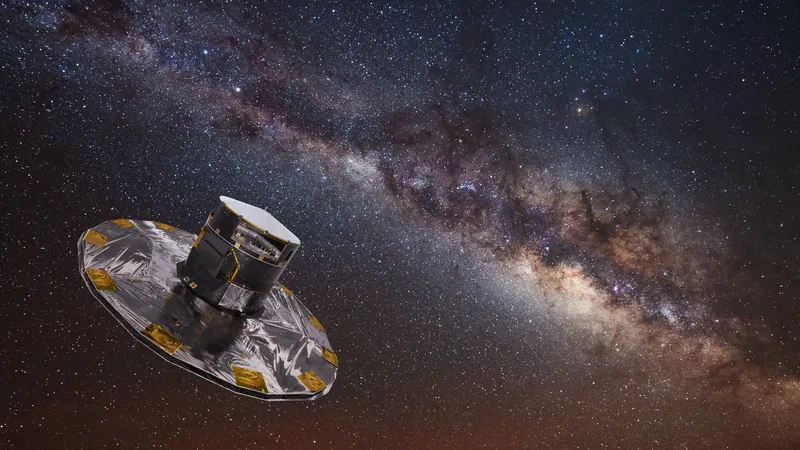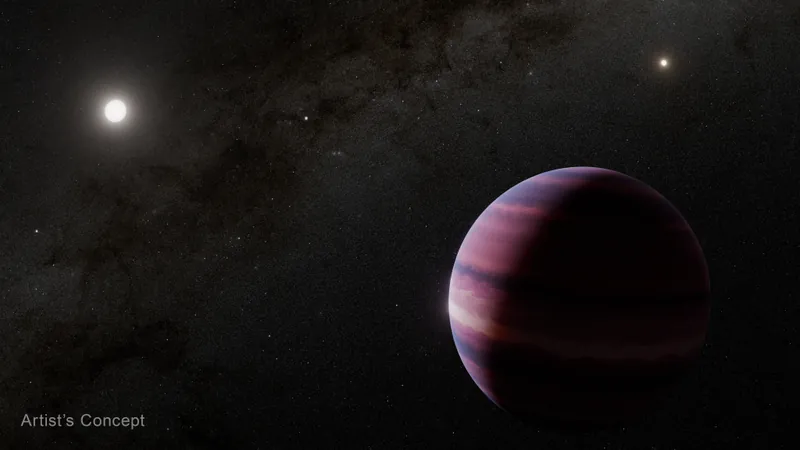
Revolutionary Discovery: Rare Exoplanet Found at the Galactic Edge Using Einstein's Theory!
2025-06-27
Author: Jia
Astronomers Unveil a Hidden Gem in Our Galaxy
In an awe-inspiring breakthrough, astronomers have uncovered a unique exoplanet located at the farthest reaches of the Milky Way, employing a fascinating space-time phenomenon predicted by the legendary Albert Einstein.
Meet AT2021uey b: Jupiter's Remote Cousin
Named AT2021uey b, this gas giant, comparable in size to Jupiter, lies approximately 3,200 light-years from Earth. Orbiting a cool, dim M dwarf star every 4,170 days, AT2021uey b is only the third known exoplanet discovered so far from the galactic center, highlighting its rarity.
A Discovery Like No Other: The Power of Microlensing
What sets this discovery apart is the innovative technique used to identify the exoplanet—microlensing. This extraordinary effect occurs when the light from a distant star is magnified due to the gravitational influence of a planet, thus warping the space-time around it. This groundbreaking finding was published on May 7 in "Astronomy & Astrophysics."
A Long Road to Discovery
"This kind of work requires expertise, patience, and a dash of luck," shared Marius Maskoliūnas, a co-author of the study from Vilnius University in Lithuania. The rare alignment between the source star and the lensing planet means waiting and sifting through an ocean of data, as 90% of observed stars flicker for other reasons.
The Rarity of Exoplanets
Since the first exoplanet was confirmed in 1992, nearly 6,000 alien worlds have been identified. The most common detection methods, transit photometry and radial velocity, primarily observe the dimming of stars or the star's wobble caused by planetary pulls. Yet, microlensing remains a less common but powerful tool.
Einstein's Shadow Play: How Microlensing Works
Rooted in Einstein's theory of general relativity, microlensing reveals the hidden cosmic bodies through their gravitational shadows. As Maskoliūnas intriguingly described, it's like perceiving the shadow of a bird flying by—one may not see the bird itself but can deduce its size and distance.
The Cosmic Origins of AT2021uey b
AT2021uey b was initially detected in 2021, thanks to the European Space Agency's Gaia telescope, which recorded a sudden brightness spike from its host star. With subsequent observations from Vilnius’s Molėtai Astronomical Observatory, researchers confirmed this gas giant's mass is 1.3 times that of Jupiter's.
A New Frontier in Planet Discovery
Remarkably, AT2021uey b exists in a region of the Milky Way that is relatively lacking in the heavy elements essential for planet formation. This discovery opens new avenues in the quest to understand where planets can form, challenging our preconceived notions of celestial neighborhoods.
The Search Continues!
As astronomers explore the cosmos further, discoveries like AT2021uey b not only enrich our understanding of the universe but also highlight the astonishing potential of scientific techniques grounded in Einstein’s timeless theories.

 Brasil (PT)
Brasil (PT)
 Canada (EN)
Canada (EN)
 Chile (ES)
Chile (ES)
 Česko (CS)
Česko (CS)
 대한민국 (KO)
대한민국 (KO)
 España (ES)
España (ES)
 France (FR)
France (FR)
 Hong Kong (EN)
Hong Kong (EN)
 Italia (IT)
Italia (IT)
 日本 (JA)
日本 (JA)
 Magyarország (HU)
Magyarország (HU)
 Norge (NO)
Norge (NO)
 Polska (PL)
Polska (PL)
 Schweiz (DE)
Schweiz (DE)
 Singapore (EN)
Singapore (EN)
 Sverige (SV)
Sverige (SV)
 Suomi (FI)
Suomi (FI)
 Türkiye (TR)
Türkiye (TR)
 الإمارات العربية المتحدة (AR)
الإمارات العربية المتحدة (AR)